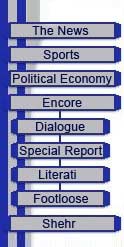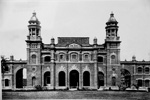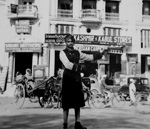



|
|
 |
 |
 |
                                                             
|
city Revisiting glory of The Mall A glimpse of “Victorian Lahore” from 1870-1970. Old pictures of Lahore’s Mall Road give a sense of peace, calmness and discipline to the viewers By Waqar Gillani If you wants to see peace and calm at The Mall or an exhibition of assets, arms and arsenals given to Pakistan after the Indo-Pak partition or the historic Mall Road without the Punjab Assembly building, rush to National College of Art’s Zahoorul Ikhlaq Gallery exhibiting one hundred years old (1870-1970) pictures of the road. MOOD
STREET Town
Talk development A
longing for birds
Revisiting glory of The Mall A glimpse of “Victorian Lahore” from 1870-1970. Old pictures of Lahore’s Mall Road give a sense of peace, calmness and discipline to the viewers By Waqar Gillani   If you wants to see
peace and calm at The Mall or an exhibition of assets, arms and
arsenals given to Pakistan after the Indo-Pak partition
or the historic Mall Road without the Punjab Assembly building, rush to
National College of Art’s Zahoorul Ikhlaq Gallery exhibiting one hundred
years old (1870-1970) pictures of the road. The exhibition, based on
more than 100 unique pictures of The Mall, gathered from different
archives and scheduled to conclude on Sunday showcases the British era
constructed over 160 years old Mall Road now considered the heart of
historic city of Lahore. This display is the sole effort of Rao Javed, a
Lahore archives lover who has collected these pictures from door to door
in the past 11 years. The exposure of the old
Mall Road through these rare collections paints quite a different culture
and glimpses of the “Victorian Lahore” as compared to The Mall of
today. It presents a peaceful, and pollution-free environment in black and
white background. “It is fantastic and
fascinating,” says Masud Akhtar, a sixty year old pharmaceutical by
profession who was engrossed in these rare photographs and took some
pictures through his cellular phone. “I am a lover of old Lahore and
there are a few pictures which I have never seen in my life,” he tells
The News on Sunday (TNS) while pointing out to a picture in which the then
British Governor General is handing over the Punjab Assembly building keys
to a Sikh contractor in an impressive and formal ceremony. “I feel that
was a beautiful time,” he says, adding, “We ca Thirty-eight year old
Rao Javed, the exhibitor and collector of these archives from different
sources, is fond of unique collections of Lahore’s historic buildings
and sites. “I started this work in 2000,” he tells TNS, adding, “I
have set up a private museum at my house full of Lahore’s rare
pictures.” He developed this passion of collecting pictures and taking
interest in the historic sites and places when he visited Lahore Fort
while coming from his hometown Rajpoot Nagar, a village in district Okara.
“I came to see my uncle in Lahore and then we went to Lahore Fort. After
that I A bunch The exhibition’s
closing has been extended seeing the interest of general public, till
Sunday (today).
When I came to live in
the city about a decade ago, I was already in love with the city for all
that it stood for — beauty, romance, art and culture. This image of
Lahore I had culled out of books. I was particularly fascinated by the
Walled City and The Mall. If the old city was said to be citadel of old
traditions and values, the road was mentioned as some very romantic place
where lovers met and where literati strolled in the evenings. Having lived in the city
for over ten years now, I know this is not the ideal that I came hankering
after. The cultural heart of the subcontinent is inundated with noise and
pollution; ugly urbanisation seems to have mutilated its traditional face. As a student, I would
reserve my off days from the university to see the old parts of the city
and famous archaeological sights. Those visits were eye-opening to say the
least; the city portrayed in history books and Manto’s stories was now
full of narrow, filthy streets; poverty-stricken faces; cracked buildings,
ready to fall any moment. The area carried a deeply wounded air around it.
It was as if one went to see a wonderfully beautiful tawaif but what one
witnessed instead was an ailing prostitute, deserted by her lovers and
left to rot in sickening poverty. Disillusioned, I stopped
going to the area. I was always fond of
long walks but nerve-testing noise mocked me whatever road of the city I
set foot on. There were no footpaths along a majority of roads and those
which had some footpath-like pavements were either encroached upon by
vehicles or stalls or garbage. Except for the wee
hours, what defined the city was noise and pollution and billboards,
advertisements and posters across the city walls. I missed the serenity of
rural life. Early morning walks in the city parks like Lawrence Garden and
Race Course calmed my noise-infested mind and soul. But how fleeting those
moments were! With the sun a bit high in the sky, the monstrous sounds of
shrieking vehicles would distort the soft morning calm. If other city roads
disappointed me greatly due to their aesthetic dryness, The Mall was not
unkind at all. In a bus, or sometimes in some friend’s car, travelling
on the road was never without its rewards. Green trees and historical
buildings along it were always a feast to the aesthetic sense. The main
artery of the city stood the wear and tear of times. Though it too was not
without noise and rush during day, late night strolls along the way were
mesmerising. On my way to office,
situated near Charing Cross, I would look forward to the time when I would
have all the late night stillness, quiet melodies and sparkling
semi-darkness on the way back to my hostel in Anarkali. At that time, the
city seemed to be almost asleep and the road would echo its glorious past.
The night would somehow hide the ugliness of modernity and bring forth its
hidden past glory. Once again, I could imagine the road on which “girls
in jeans would go to the Government College on bicycle in 70s’’ and
“the English ladies would stroll in the evenings back in 30s.” Images and words form
our memories, connecting us with the past, both at a personal and
collective level — this is what a photo exhibition at NCA ‘Revisiting
The Mall’ did. The black and white photos of various buildings took us
back in time. It was a hundred-year history of the road. Wrapped in past
traditions, the old city and The Mall of the past have come alive in the
pictures. It seems to wear the look of a culturally rich and well-organised
city. A speaker at the exhibition was right to term it “a city as great
as Paris, Prague, and Barcelona”. Cities are like human
beings. What is soul to the latter, greenery and culture is to the former.
With high structures and machines encroaching upon it, no wonder the city
and its dwellers find it hard to breathe.
*Exhibition of Drawings
& Paintings by Ali Abbas in Ejaz Art Gallery on Thursday, Dec 22 from
5–9 pm. The exhibition will remain open until Dec 29. *Exhibition titled Conch
Curve Creation by Ali Asad Naqvi at The Drawing Room Art Gallery till Dec
26. *Exhibition at Grey
Noise of Bani Abidi’s works in collaboration with Green Cardamom, London
till Jan 13. Gallery timings: 5pm-9pm. *Weekend Cycle Ride to
start from Neela Gumbad parking lot today at 10:30am.
development The Punjab
government’s plan to set up a network of playgrounds in the city has
received mixed response from the public. Though on paper things seem quite
simple, the reality is different. The initiative which enjoys
extraordinary support of Punjab Chief Minister Shahbaz Sharif envisages
development of above 100 playgrounds in the city on a public-private
partnership basis. Corporate and business sponsorships have also been
invited to cover the cost of running these grounds. Many chunks of the land
on which these playgrounds are being built have been recovered from
encroachers and land mafias. Besides, there are those also which are owned
by the government itself and the ones existing in housing schemes
developed by Lahore Development Authority (LDA). Furthermore, citizens
have been asked to identify illegally occupied lands so that they can also
be used for the same purpose. The playgrounds
according to the plan would be custom-made for sports like cricket,
football, hockey, volleyball, baseball, tennis, badminton, jogging etc. There have been a couple
of cases where the residents of the area have objected to the plan on the
basis it would disturb their privacy and security. Their major concern is
that they have not been taken on board and their opinion not incorporated
while making decisions like constructing cricket grounds in residential
areas. Haji Muhammad Javed,
resident of Gujjarpura Housing Scheme developed by LDA contests the
planned conversion of a 20 kanal ground in C1 block into a cricket ground.
He tells TNS the area is too small to be converted into a cricket ground
as it’s surrounded from all four sides by houses. Even a child can
understand that in such a case the surrounding houses will suffer immense
damage due to the nature of this sport, he says. “We have no objection
if they make a play area for children, jogging track etc but cricket
ground is out of question.” He says even the practice nets are
non-viable as cricket ball hit hard can smash windows, injure the
residents and damage vehicles standing there. Javed, who is also the
president of Gujjarpura Housing Scheme Welfare Society (GHSWS), tells TNS
it’s strange they are setting up this ground despite having two sports
complexes in the same area. Chaudhry Azhar Manzoor,
secretary GHSWS, claims under LDA law land allocated for a purpose cannot
be used for some other purpose. Under this law, the Lahore High Court
stayed conversion of a public park into plots in Journalists Housing
Colony Harbanspura. “We also seek relief on this ground,” he says
adding conversion of a park for locals into a commercial venture is
totally unacceptable. Azhar complains the
Parks and Horticulture Authority (PHA) has dug the park in front of their
houses and cut dozens of trees surrounding it. The park which once used to
be a garden full of flowers is now a devastated place. “Many of us
bought expensive plots here as there was a beautiful park exclusively for
residents’ use.” Now the prices have plummeted as nobody wants to live
on the edge of an under-sized cricket ground. PHA response Javed Shaida, Deputy
Director at PHA tells TNS many people are worried about things which are
not going to happen. They are approaching courts and raising hue and cry
as they are used to getting cheated in the past. “I want to assure them
that this time the government under the leadership of Punjab CM wants
business. The only objective is to provide the citizens best possible
recreational and sports facilities. Shaida says they will
definitely ensure that cricket grounds are only constructed at places
where there is sufficient distance between the wicket and the residences
surrounding it. The grounds reserved for women will be used only by women
and those for children by children alone. He also contests the allegations
that the locals are not being taken on board while taking these decisions.
“How can we ignore them? They are the ones who will have to look after
the affairs of these playgrounds and ensure no unwanted elements are seen
there.” Shaida says it does not
mean PHA will not look after the affairs of the playgrounds. It will take
the responsibility of maintenance but the management must be the
responsibility of the locals who practically own them. He tells TNS it goes to
the credit of the present government that it recovered encroached lands
from mafias and instead of selling those for billions used them in
people’s interest. There were lands owned by Auqaf department where
people were illegally cultivating for generations. Similarly, there were
areas like Kamahan village near Ferozepur Road where illegal occupiers had
kept cattle, donkeys and other animals. When government challenges them
they raise hue and cry and approach courts. They may get interim relief
but when PHA explains real situation in the court they have to suffer.
A
longing for birds Not a very long time
ago, Lahoris woke up to chirping of different birds. But in recent past
these sounds have been silenced by unchecked and unsustainable development
and human settlement — compared to 240 bird species recorded in Lahore
in 1965, only 101 bird species were recorded in 1992. Ornithologists
estimate there are currently only 85 bird species left in Lahore,
including resident and migrant species. The city has expanded
immensely in the past six decades. Because of people coming in huge
numbers from surrounding areas in search of better livelihood, the housing
increased rapidly, and is still growing. Additionally, local businesses
paved way for conversion of previously protected areas, such as parks and
open public spaces, into business zones. Along with these modern
additions, ancient monuments, old gardens, bungalows with attached gardens
and old roadside trees (some of them can still be seen) are gradually
disappearing. The few remaining are places like the Lahore Zoo, Lawrence
Garden, Mayo and Jinnah Gardens, GOR, Jallo Park, Kinnaird College,
Aitchison College. These old endemic trees of Lahore are home to many
resident bird species as well as many summer, winter and transit migrants.
In the absence of proper
development strategies haphazard constructions have taken place. Local
leaderships have further allowed felling of trees, filling in marshes and
levelling parks. The situation is not just aesthetically unpleasant; it is
a challenge to the environment and ecology. The most visible of
Lahore’s birds today are the common house sparrows, grey hombills,
yellow-footed green pigeons, bulbuls, doves, spotted owlets, mynas,
woodpeckers, crows, kites, ashy prinia, redstarts and oriental white eyes
etc. Birds migrate here from southern parts of the country in warmer
months for food and breeding purposes and in colder months in search of
food. They feast on small insects, spiders and soft seeds from moist soil
which is becoming rarer now as Lahore has less agricultural land. Abid Ali Chohan, a
student of Environmental Sciences says, “To maintain and to increase the
number of bird population in Lahore, Ministry of Environment, government
departments like Parks and Horticultural Authorities ( PHA) and NGOs like
WWF need to plant trees and vegetation like bushes and thickets so that
they can attract birds. “There should be
strict implementation on the Punjab Wildlife Act 1974. A solution would be
to create widespread awareness and bring back the horticulture of the
1940s on a municipal and district level in new colonies to give a chance
to the original bird species to flourish. City District Government should
play a key role in this regard. Local authorities should adopt procedures
that require ecological surveys and urban environment surveys which will
minimise damage to not just birds but human health as well,” he says. Z.B Mirza, author of
Birds of Pakistan says, “I have seen cranes in the wetland of Keeran
village west of Model Town. But where man has taken away, nature has
given. Some birds have successfully adapted in the face of urbanisation
becoming resilient against change and this is ensuring their continued
breeding and sustenance.” Ornithologists confirm
that bird species which rely on endemic flora of Lahore are still at risk
as there is a dangerous trend towards replacing indigenous plant species
with exotic ones. “The important thing is that trees such as pipal,
kikar, bair, jamun, mango, saru and neem in which these birds used to
inhabit are being cut to make space for modern developments, thus
threatening the survival of bird species.” Just as most of our
national treasures go unnoticed, the birds of Lahore also garner little or
no attention. With new technologies, we might as well watch a red- vented
bulbul and a rosy starling on our computer screens, rather than venturing
outside. It is time for all to rethink our lifestyles and find ways to
co-exist with nature’s finest creations. Salmanali088@gmail.com |
|